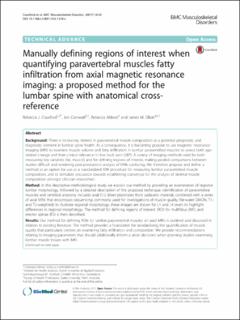Please use this identifier to cite or link to this item:
https://doi.org/10.21256/zhaw-4717| Publication type: | Article in scientific journal |
| Type of review: | Peer review (publication) |
| Title: | Manually defining regions of interest when quantifying paravertebral muscles fatty infiltration from axial magnetic resonance imaging : a proposed method for the lumbar spine with anatomical cross-reference |
| Authors: | Crawford, Rebecca J. Cornwall, Jon Abbott, Rebecca Elliott, James M. |
| DOI: | 10.21256/zhaw-4717 10.1186/s12891-016-1378-z |
| Published in: | BMC Musculoskeletal Disorders |
| Volume(Issue): | 18 |
| Issue: | 25 |
| Issue Date: | 2017 |
| Publisher / Ed. Institution: | BioMed Central |
| ISSN: | 1471-2474 |
| Language: | English |
| Subjects: | Erector spinae; Fat infiltration; Lumbar spine; Manual segmentation; Multifidus; Paravertebral muscles; Region of interest; Adipose tissue; Lumbar vertebrae; Magnetic Resonance Imaging; Skeletal muscle |
| Subject (DDC): | 617.5: Orthopaedic surgery |
| Abstract: | Background: There is increasing interest in paravertebral muscle composition as a potential prognostic and diagnostic element in lumbar spine health. As a consequence, it is becoming popular to use magnetic resonance imaging (MRI) to examine muscle volume and fatty infiltration in lumbar paravertebral muscles to assess both age-related change and their clinical relevance in low back pain (LBP). A variety of imaging methods exist for both measuring key variables (fat, muscle) and for defining regions of interest, making pooled comparisons between studies difficult and rendering post-production analysis of MRIs confusing. We therefore propose and define a method as an option for use as a standardized MRI procedure for measuring lumbar paravertebral muscle composition, and to stimulate discussion towards establishing consensus for the analysis of skeletal muscle composition amongst clinician researchers. Method: In this descriptive methodological study we explain our method by providing an examination of regional lumbar morphology, followed by a detailed description of the proposed technique. Identification of paravertebral muscles and vertebral anatomy includes axial E12 sheet-plastinates from cadaveric material, combined with a series of axial MRIs that encompass sequencing commonly used for investigations of muscle quality (fat-water DIXON, T1-, and T2-weighted) to illustrate regional morphology; these images are shown for L1 and L4 levels to highlight differences in regional morphology. The method for defining regions of interest (ROI) for multifidus (MF), and erector spinae (ES) is then described. Results: Our method for defining ROIs for lumbar paravertebral muscles on axial MRIs is outlined and discussed in relation to existing literature. The method provides a foundation for standardising the quantification of muscle quality that particularly centres on examining fatty infiltration and composition. We provide recommendations relating to imaging parameters that should additionally inform a priori decisions when planning studies examining lumbar muscle tissues with MRI. Conclusions: We intend this method to provide a platform towards developing and delivering meaningful comparisons between MRI data on lumbar paravertebral muscle quality. |
| URI: | https://digitalcollection.zhaw.ch/handle/11475/11501 |
| Fulltext version: | Published version |
| License (according to publishing contract): | Licence according to publishing contract |
| Departement: | School of Health Sciences |
| Organisational Unit: | Institute of Public Health (IPH) |
| Appears in collections: | Publikationen Gesundheit |
Files in This Item:
| File | Description | Size | Format | |
|---|---|---|---|---|
| 2017_Crawford_Manually_defining_regions_of_interest.pdf | 1.28 MB | Adobe PDF |  View/Open |
Show full item record
Crawford, R. J., Cornwall, J., Abbott, R., & Elliott, J. M. (2017). Manually defining regions of interest when quantifying paravertebral muscles fatty infiltration from axial magnetic resonance imaging : a proposed method for the lumbar spine with anatomical cross-reference. BMC Musculoskeletal Disorders, 18(25). https://doi.org/10.21256/zhaw-4717
Crawford, R.J. et al. (2017) ‘Manually defining regions of interest when quantifying paravertebral muscles fatty infiltration from axial magnetic resonance imaging : a proposed method for the lumbar spine with anatomical cross-reference’, BMC Musculoskeletal Disorders, 18(25). Available at: https://doi.org/10.21256/zhaw-4717.
R. J. Crawford, J. Cornwall, R. Abbott, and J. M. Elliott, “Manually defining regions of interest when quantifying paravertebral muscles fatty infiltration from axial magnetic resonance imaging : a proposed method for the lumbar spine with anatomical cross-reference,” BMC Musculoskeletal Disorders, vol. 18, no. 25, 2017, doi: 10.21256/zhaw-4717.
CRAWFORD, Rebecca J., Jon CORNWALL, Rebecca ABBOTT und James M. ELLIOTT, 2017. Manually defining regions of interest when quantifying paravertebral muscles fatty infiltration from axial magnetic resonance imaging : a proposed method for the lumbar spine with anatomical cross-reference. BMC Musculoskeletal Disorders. 2017. Bd. 18, Nr. 25. DOI 10.21256/zhaw-4717
Crawford, Rebecca J., Jon Cornwall, Rebecca Abbott, and James M. Elliott. 2017. “Manually Defining Regions of Interest When Quantifying Paravertebral Muscles Fatty Infiltration from Axial Magnetic Resonance Imaging : A Proposed Method for the Lumbar Spine with Anatomical Cross-Reference.” BMC Musculoskeletal Disorders 18 (25). https://doi.org/10.21256/zhaw-4717.
Crawford, Rebecca J., et al. “Manually Defining Regions of Interest When Quantifying Paravertebral Muscles Fatty Infiltration from Axial Magnetic Resonance Imaging : A Proposed Method for the Lumbar Spine with Anatomical Cross-Reference.” BMC Musculoskeletal Disorders, vol. 18, no. 25, 2017, https://doi.org/10.21256/zhaw-4717.
Items in DSpace are protected by copyright, with all rights reserved, unless otherwise indicated.